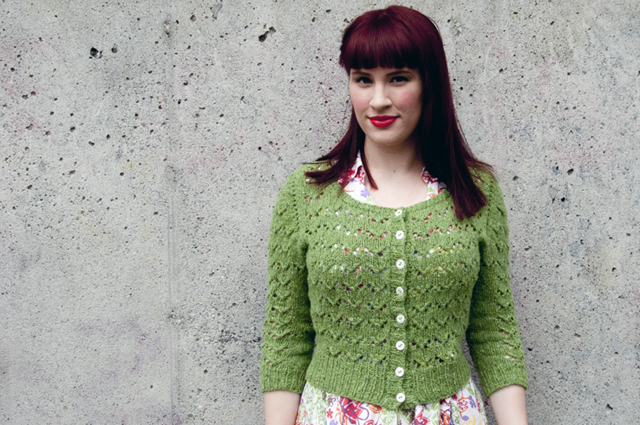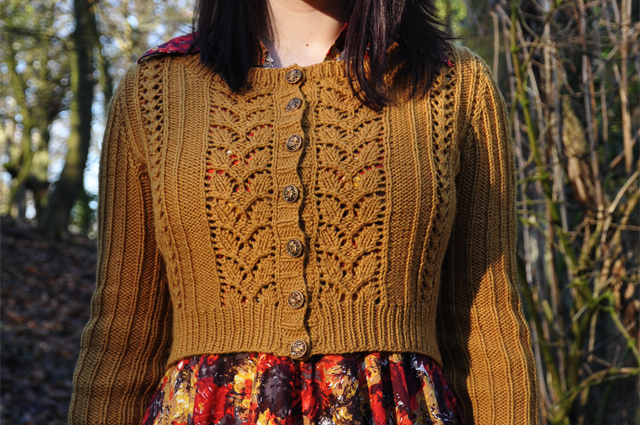
Whenever it’s possible, I like to write my patterns so you can choose between following written instructions or charts for the stitch patterns. That means that the stitch patterns end up separate from the rest of the pattern, and the pattern will say “work stitch pattern A” or “work stitch pattern B” in the appropriate spot, and the knitter has to pop in the stitch pattern there and keep track of the stitch patterns themselves. It’s pretty easy once you get going and understand what is going on.

When you first run across the instructions “work stitch pattern __,” you always want to start with the first row of the stitch pattern unless the main pattern tells you otherwise. Sometimes the first row of the stitch pattern might be a plain row, like all knits or all purls, but the first row is the first row, so that’s the one you should knit, even if it’s not exciting. From there, every time you see the instructions “work stitch pattern __,” you work the next row in the stitch pattern so you progress all the way through it. Once you’ve knit all the rows in the stitch pattern, you start over with the first row again and continue like that. It will be up to you to keep track of what row of the stitch pattern you’re on because the stitch pattern’s row numbers won’t correspond with the main pattern’s row numbers once you get going.
Let’s imagine we’re working with some panels here so I can illustrate what is going on. Although it doesn’t really matter and this applies to lace, cables, and colorwork alike, this will be our stitch pattern for my examples:

Here is the example main pattern instructions:
Row 1: K4, work stitch pattern A, k9, work stitch pattern A, k3.
Row 2: P3, work stitch pattern A, p9, work stitch pattern A, p4.
Repeat the previous 2 rows 5 more times.
Note that what you’re repeating is the instructions for these rows, not the identical rows themselves, so you would continue to progress through the different rows of the stitch pattern like you would normally. For the first two rows of the pattern, you’d work rows 1-2 of the stitch pattern because you always start with the first row of the stitch pattern and progress through unless otherwise instructed. When you repeat the two rows of the pattern, you’d repeat the instructions and therefore continue to progress through the stitch pattern with stitch pattern rows 3 and 4.
If you find that a little confusing, think about instructions that have you work until a marker and increase. When you repeat those rows you repeat the instructions, not the exact version of the rows you knit the first time. It works the same way here, and this is how those instructions would look if we follow them correctly:

Easy enough, right? Now let’s look at an all over stitch pattern. It’s worked just like the panel version, but the chart is also repeated horizontally. I think the horizontal repeats might be what causes confusion with this style because where people see instructions to work the stitch pattern multiple times, they might jump to the conclusion that they’re supposed to work full vertical repeats multiple times, even when the instructions are for just one row. If you ever find yourself confused, look for context clues. How is the rest of the pattern written? Is there any indication of how many rows this set of instructions applies to? Are there neighboring stitches to knit in this set of instructions? Taking the time to read the pattern closely will spare you a lot of ripping back.
Here are our sample instructions with the stitch pattern repeated horizontally:
Row 1: K4, work stitch pattern A 3 times, k3.
Row 2: P3, work stitch pattern A 3 times, p4.
Repeat the previous 2 rows 5 more times.
And this is what it should look like:

Last but not least, I sometimes get questions from people who want to know how many vertical repeats are in a section or what row of the stitch pattern they should be on at the end of the section. Full vertical stitch pattern repeats aren’t always going to fit nicely into the section you’re working on, and that’s not accidental. You want your armhole to be the depth your armhole needs to be, not the depth that full repeats fit nicely into, and you’ll just pick up the stitch pattern where you left off when you continue knitting so it’s okay if it’s not a full repeat. But sometimes you just want to know so you can check your work. To find out what stitch pattern row you should be on, you can add up all the main pattern rows for your size that include the stitch pattern instructions and then divide by the number of rows in the stitch pattern. That will give you the number of full vertical repeats you should have and a fraction that indicates how far into the next repeat you are. Take the fraction and multiply it by the number of rows in the stitch pattern to get the exact row you’re on.

Leave a Reply